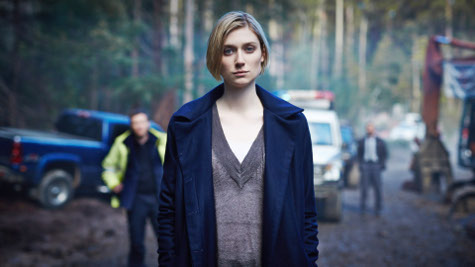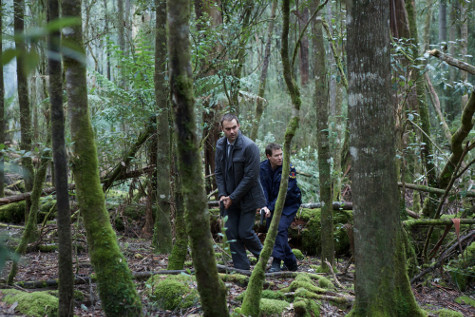
Due to book deadlines, I only watch television and film if it’s either recommended to me, of a particular beloved franchise, or directly relevant to my career in Gothic, historical and/or paranormal fiction.
The Kettering Incident, an Australian show released this summer via the Foxtel network, is set in and shot in present day Tasmania. As I am a Gothic novelist by trade, this show being a prime example of “Tasmanian Gothic” meant I had to follow the siren call.
This tradition distinguishes itself as being a unique step-child of Imperialism, born of convict settlers shipped to Australian borders; tales seem told through a dark scrying glass, worlds away from Mother England’s resources, familiarities, or institutions. It is a genre of forests and shadow. It appears to me to be the United Kingdom equivalent of our Southern Gothic.
This show is a perfect example of “place as character”—what I consider to be the most important aspect of any Gothic. The moody, striking, chilly, crisp, vast, wild, and unknowable Tasmanian setting in The Kettering Incident is a bold, intrinsic, fully participatory character in every aspect, if not nearly every shot of the story.
 The show centers on Anna Macy, a young London doctor who finds herself mysteriously drawn back to her childhood home in Kettering, Tasmania. Anna must knit together the pieces of her history, herself, and her memory and confront the last place she saw her best friend before her mysterious disappearance, known as “The Kettering Incident.” A flurry of UFO tales and cults followed.
The show centers on Anna Macy, a young London doctor who finds herself mysteriously drawn back to her childhood home in Kettering, Tasmania. Anna must knit together the pieces of her history, herself, and her memory and confront the last place she saw her best friend before her mysterious disappearance, known as “The Kettering Incident.” A flurry of UFO tales and cults followed.
The small town has a tense relationship with Anna—many thought she killed her friend years ago. However, a body was never found, and the relationship remains fraught as the town begins experiencing other crime and strange phenomena that revolve around mysterious lights in the sky and in the forest.
Doctor Macy, from the start, suffers from episodes of unconscious loss of time and waking up in unknown or unplanned spaces, writing in a notebook all her lapses that don’t yet track. Her own body seems as much a mystery as her murky past and unfolding present. Foreboding events rock the modest town, whose industries of shellfish and timber are threatened and destabilized by an area off-limits to the public. Various side plots interweave and showcase mysteries that are exposing themselves, while others try to keep secrets hidden.
My feelings on the full season are extraordinarily mixed, and I find that as frustrating as I find it interesting. I keep pulling on threads of vague discontent to find there’s more substance to the fiber. Being off-put might have precisely been the intended reaction.
The most striking thing about this series is how it is shot. It is gorgeous. Creepy. Lush and green and alternately very dark. If I could pick one word for the series, it would be lurking. A good Gothic sensibility indeed. I pictured Stephen King’s Bangor, Maine as this exact kind of stunning, verdant, terrifying void.

There are several women running production, creation, and writing on the series, as well as strong actresses at the core of the narrative, which is always heartening to see. The performances were, across the board, very solid, grounded, and real—even if I found many of the characters troubling.
The total absence of characters of color, save for one priest in the few final scenes, was disappointing, though another notable product of Imperialism. I suppose going for a small, somewhat hostile white town is indeed a choice, but as race was never directly mentioned as a factor, the absence of any characters of color struck me as odd. I grew up in a small (sometimes hostile) mostly white town, but, even so, there were at least a few people of color in my friendship circles. While this show is hardly realism—paranormal, sci-fi, and horror elements reign supreme—there was an attempt at verisimilitude in the town itself, so lack of inclusion is evident.
I’m left uneasy, and perhaps the show should count that as a certain victory. I am unsettled, not necessarily for one specific thing it did wrong, but something that’s just remained under my skin, keeping me from fully giving over to the premise and the characters. There was a detachment I couldn’t seem to cross, similar to the isolation of the characters on the island.
Friend or foe is difficult to determine, familial bonds are precarious at best, and the greatest pathos in the series comes from Eliza Grayson, an introverted, lonely young girl struggling to find a way out of the prison of a town that hasn’t done right by her. Unwelcome with either parent, at one point she plaintively asks an acquaintance for a hug so she “won’t disappear.” That was the most clarion, rich point in the series for me, delivered by a side character.
I felt Anna Macy could, as a character, disappear, and I wouldn’t necessarily know any different or miss the presence or effect she had. She floats through the show like a leaf on a stream. There’s a listlessness that’s almost maddening. When the final reveal is unveiled, I suppose one could make a case for that specific quality, but that’s a tough sell when you’re asking people to devote time and energy to your long-form story. Vague unease is often the precise effect that a lot of great sci-fi, horror, and mystery—and certainly the Gothic—intend for a great portion of the story’s journey; I’m just not sure we’re to end there, dangling, wondering if it was worth it or where, exactly, we wandered to.
And yet, I’m here talking about the show. I’m caught wondering if I have the right to demand that characters be likeable. Having unsettling characters is a perfectly valid choice, especially in this version of a Gothic, where everything is a bit off. Being put off by the town is why Anna Macy left—she doesn’t belong. I don’t feel I did either. Perhaps there’s kinship in that.
Perhaps I was affected on a more personal level than I could have predicted; the suffocating feeling of being in a small conservative town and wondering how to extract. I left mine for New York City. I wanted Anna to truly snap into brilliant doctor mode and regain fight, drive, vivacity; a continuous momentum I could personally relate to, aspects I thought her capable of.
Yet, she fell short and didn’t always add up. Part of this may be answered in or summed up by what we see in the final episode. Perhaps more in a Season 2 if there is one. I’ll watch, if only to see if I can sort this out further and hope they tie up their dangling threads.
Truth be told, The X-Files maddened me just as much, and I’m still loyal, heaven help me, to that franchise. So if you’re in that boat, and you’ve a penchant for a verdant green Gothic with legitimately creepy flair, then you might find a familiar and fraught siren song in The Kettering Incident.
Read Leanna Renee Hieber's thoughts on Stranger Things!
Leanna Renee Hieber, actress, playwright, artist and award-winning, bestselling author, has written nine Gothic Victorian Paranormal novels for adults and teens, set in 1880s New York City and London. Her Strangely Beautiful saga hit Barnes & Noble and Borders Bestseller lists, garnered numerous genre awards, and has reissued in a special edition from Tor. Her new Gaslamp Fantasy trilogy, The Eterna Files, an X-Files meets Penny Dreadful kind of series, is now available from Tor, including the sequel Eterna and Omega.
Active on Twitter @LeannaRenee and Facebook /lrhieber, more about her work and art, as well as free reads and writing resources, can be found at http://leannareneehieber.com

It’s going to be complicated and private between two brothers. And William and Harry have already faced the hard-to-measure sense of loss at an early age, with the death of their mother Diana.